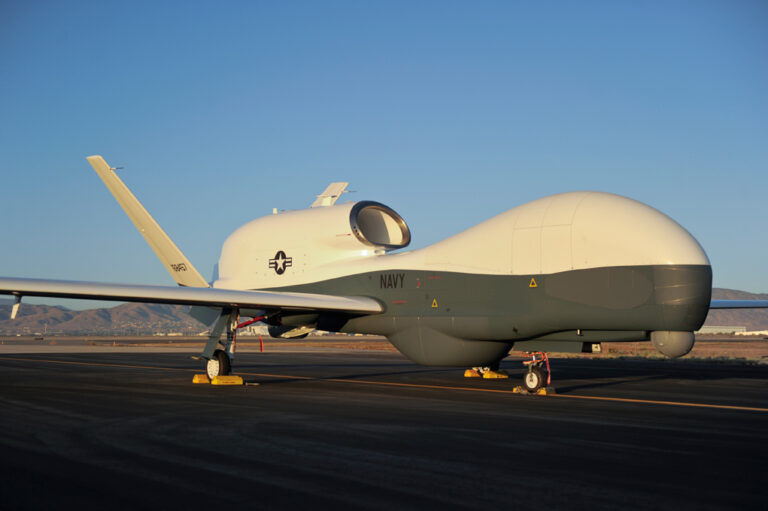Stay Up to Date
Submit your email address to receive the latest industry and Aerospace America news.
Rear admiral says better tech is needed before unmanned planes can autonomously avoid other aircraft
The U.S. Navy will deploy its first two MQ-4C Triton unmanned surveillance aircraft by the end of 2018 without sense-and-avoid radars that would give the planes limited autonomy to avoid other aircraft, says a rear admiral who hopes that upgrade will be ready by 2021.
The planes, built by Northrop Grumman, are destined for Guam, from which they will carry maritime radars to detect ships from 55,000 feet, eventually for as long as a day at a time.
The separate sense-and-avoid radar originally designed for the Tritons “wasn’t optimized for how it was going to operate,” said Rear Adm. Mark Darrah, during a panel discussion Wednesday at the Navy League’s Sea, Air and Space Exposition in Maryland. So the aircraft will be sent to Guam “with the basics we require” to safely navigate international airspace aided by the Automatic Dependent Surveillance-Broadcast flight tracking network and ground radar stations, he said.
Darrah spoke about the need to improve technology for unmanned planes to sense other aircraft, and to process that information to avoid collisions.
“We’ve got to do some work on application of the algorithms and the processing based on the class of system we are going to provide sense-and-avoid for,” said Darrah, who is program executive officer for U.S. Navy unmanned aviation and strike weapons.
“Same thing for the underwater systems,” he added, noting that U.S. Navy unmanned ships being developed to monitor oceans above and beneath the waves need better technology to respond to their surroundings.
The first two Tritons will be deployed to Guam by the end of 2018 after operational tests at the Naval Air Warfare Center Weapons Division in Point Mugu, California. Additional Tritons will be deployed to Guam by 2021, the Navy said.
Darrah told me after the panel discussion that the Navy aims to add sense-and-avoid technology to the Tritons by 2021. Controllers on the ground will attend to the aircraft, but this upgrade could add limited autonomy for sensing other aircraft while meeting U.N. International Civil Aviation Organization safety rules, he says.
“Sense-and-avoid is an unmanned challenge we have to deal with, whether it is commercial or military” Darrah says. “The radar technology isn’t the hard part, it‘s the processing of the information to decide what to do with it.”
Consumer drones can be given sense-and-avoid programming to detect their surroundings and fly autonomously through obstacle courses, but Darrah says that is simpler for smaller drones in a controlled environment without high-altitude winds that the much larger Triton would have to navigate.
“It’s got to look at how fast it is flying, its altitude, what are other conditions around it, is it experiencing turbulence, can it manage a turn and not stall the airplane,” Darrah says. “It’s got to go through all that calculation in a time frame that makes sense.”
The Navy said in a statement that technical challenges led to cost increases and schedule delays during development of the original Airborne Sense and Avoid three-panel radar that was built to fit in the nose cone of the Triton.
“The technical challenges included issues in designing and producing a system that could meet technical requirements within the available size, weight, power and cooling parameters,” the Navy said. “The Navy resumed work with the sense-and-avoid radar in 2015. Triton will have broader access to international airspace with the sense-and-avoid radar.”
About Tom Risen
As our staff reporter from 2017-2018, Tom covered breaking news and wrote features. He has reported for U.S. News & World Report, Slate and Atlantic Media.
Related Posts
Stay Up to Date
Submit your email address to receive the latest industry and Aerospace America news.




